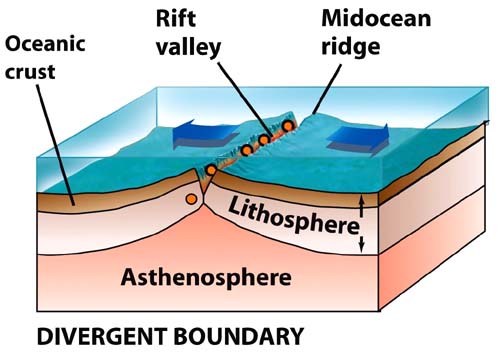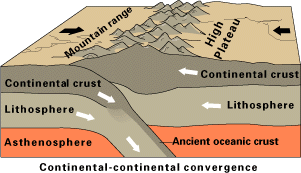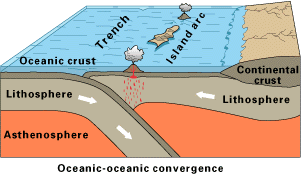After learning about the Earth’s structure and Plate Tectonics, it is known that the Earth’s plates move relative to nearby plates; therefore this will result in high geological activities such as volcanic eruptions and earthquakes at the plate margins. It is also possible to have geological activities in the middle of plates, but it is quite uncommon. There are three type of plate margins; convergent, divergent and transform.
Divergent Margins
This happens when the Earth’s plates are moving apart and a new lithosphere is created (Figure 1). In the oceans, the divergent process has produced the mid-ocean ridge system, which can also be described as a global range of underwater mountains. There are several ocean ridges such as the Juan de Fuca Ridge, the Mid-Atlantic Ridge, the Galapagos Rise and the East Pacific Rise. On land, the divergent margins create rift valleys such as the Red Sea and East African Rifts (Figure 2).

Figure 1 – Divergent Margins
(Ref Image: http://wiki.aapg.org/images/3/31/Div_boundary-ivana.jpg)

Figure 2 – East Africa Rift
(Ref Image: http://www.geo.arizona.edu/geo5xx/geos577/projects/mooney/images/usgs.gif)
Convergent Margins
The convergent margins happen when two plates are pushed together. The heavier plate will go below the lighter plate; therefore, a subduction zone is created. Heavier oceanic crush normally resonates below the lighter, thicker continental crust. Geological features associated with subduction are trench formation, earthquake, mountain building and volcanism. Images in Figure 3, Figure 4 and Figure 5 demonstrate convergent margins.

Figure 3 – Ocean – Continental Convergence
(Ref Image: https://upload.wikimedia.org/wikipedia/commons/thumb/2/29/Active_Margin.svg/500px-Active_Margin.svg.png)

Figure 4 – Continental-continental convergence
(Ref Image:https://upload.wikimedia.org/wikipedia/commons/8/83/Continental-continental_convergence_Fig21contcont.gif)

Figure 5 – Ocean-ocean convergence
(Ref Image:https://upload.wikimedia.org/wikipedia/commons/0/0c/Oceanic-oceanic_convergence_Fig21oceanocean.gif)
Transform Faults
Transform faults, also known as conservative plate boundary, happen when two Earth plates slide past one another. The movement is usually irregular and non-uniform, but it happens rapidly as a series of slip faults and the transform faults will not create or destroy a lithosphere. However, sudden movement of slip faults produce earthquakes along the faults. Figure 6 shows an illustration of transform faults.

Figure 6 – Transform Faults
http://www.indiana.edu/~tecton/notes/lecture_4-2_transform_faults_files/slide0021_image021.gif
References
Richard C. Selley, 2014. Elements of Petroleum Geology, Third Edition. 3 Edition. Academic Press.
Richard C. Selley, 1997. Elements of Petroleum Geology, Second Edition. 2 Edition. Academic Press.